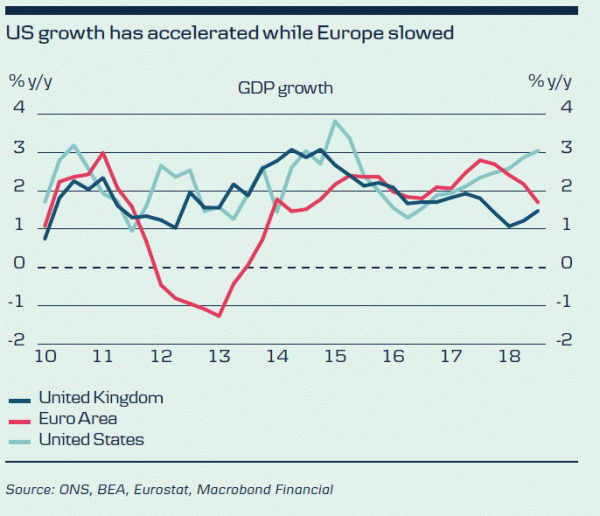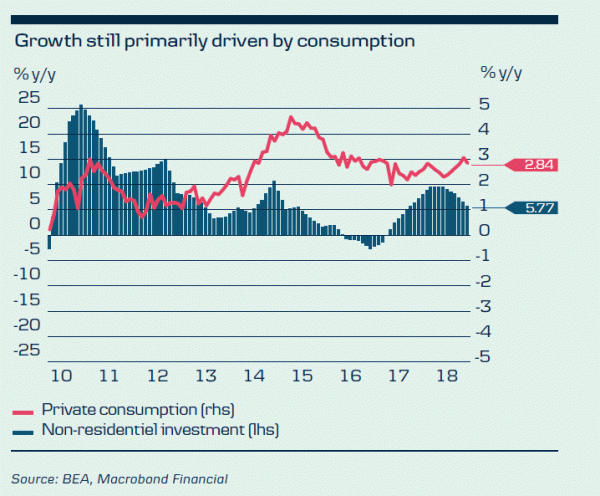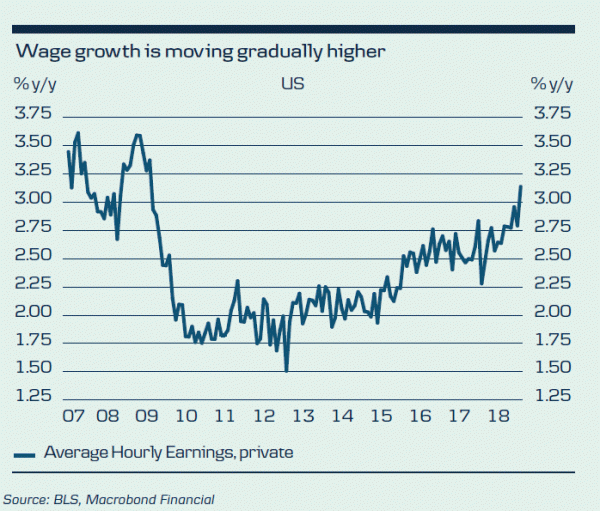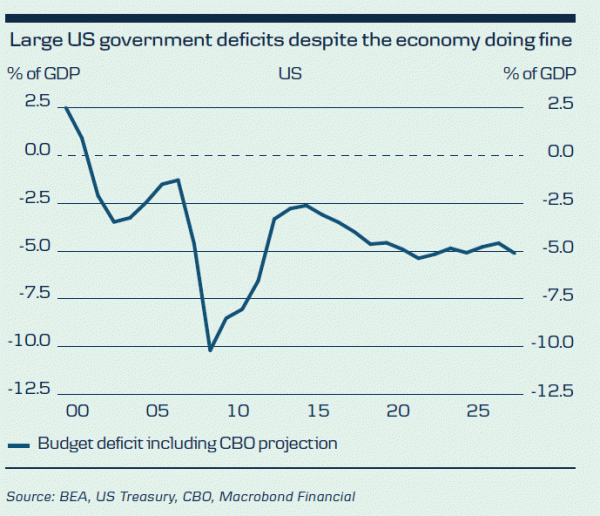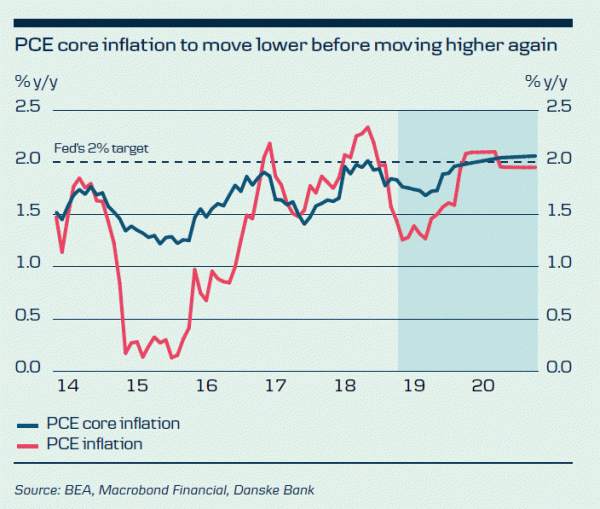- GDP growth is set to remain above potential in 2019, as fiscal policy continues to be expansionary and optimism is high. The risk of a recession is higher in 2020, but predicting the timing is difficult.
- US government debt is on an increasing path due to Trumponomics, which is unsustainable in the long run.
- Core inflation is set to move slightly higher but it is a gradual process.
- The Federal Reserve will continue to raise rates, but we still expect EUR/USD to move higher in 2019.
Next downturn unlikely in 2019
While the rest of the world has slowed, US growth has been strong with GDP growth in the range 3.5%-4.00% q/q annualised in the past two quarters and GDP growth this year is probably set to end at 3.0% y/y. The main difference between the US and everyone else is that fiscal policy is very expansionary due to Trump’s tax cuts and higher fiscal spending. In the fiscal year 2018 (covering Q4 17 to Q3 18), the CBO estimates legislative changes increased the fiscal deficit by 1.4% of GDP without taking into account the impact on the economy.
As the current expansion will soon be the longest in US history, many are asking themselves, when does the next recession hit? Not least with the flattening of the US yield curve, which is considered a reliable recession indicator. We think it is important to remember that expansion does not die of old age, meaning that just because the expansion has lasted a long time, a crisis does not have to be just around the corner.
Something needs to go wrong for the economy to turn around. We are having a hard time seeing a downturn in 2019, as optimism is still high and fiscal policy remains expansionary. The CBO estimates legislative changes add an additional 0.9% of GDP to the deficit during the fiscal year 2019 (covering Q4 18 to Q3 19), so while the fiscal boost has declined, it is still considerable.
We are more concerned about 2020, when the probability of a recession is higher, as the Fed continues to raise rates further and fiscal policy is no longer expansionary (the CBO estimates it may contract 0.5% of GDP). Other risks to the outlook are the ongoing trade war with China and the housing market, which seems to be cooling down following higher mortgage rates. We forecast GDP growth will slow over the forecast horizon. We expect quarterly GDP growth to slow to 2.2% q/q AR in 2019 and back to the range of potential growth 1.75%-2.00% in 2020. Calling the precise timing of a recession is one of the most difficult things to do, so we will abstain from that but just repeat that the risks are bigger in 2020 than in 2019.
Finally stronger wage growth
Jobs growth has been strong in 2018 with jobs growth slightly above 200,000. Many indicators suggest there is not much, if any, slack left in the labour market and that some problems are supply side issues like mismatch problems between demand for and supply of skills. We expect jobs growth will slow, as labour becomes increasingly scare, but productivity growth will probably still hover around 1%.
It has been a puzzle why wage growth has been stubbornly low in this expansion but there are signs that it has started increasing – perhaps the Phillips curve is alive after all. Wage growth is right now at the highest in this cycle and we expect it will continue to move gradually higher.
Large deficits due to tax cuts and more spending US government deficits are increasing due to the combination of deficit-financed tax cuts and higher budget spending caps, meaning a higher issuance of US Treasuries in coming years. The US Congressional Budget Office (CBO) estimates US government public debt will increase to 96% of GDP over the next 10 years on the back of deficits in the range 4-6% of GDP. Debt may even move higher if the politicians decide to extend some of the temporary elements in the budget and tax reform (or make them permanent). CRFB previously estimated government public debt may be as high as 110% in 10 yearss. Markets do not seem worried at the moment, as the low rates mean interest payments are still low but this may change, especially when the economy falls into a recession next time. Here deficits may even exceed what we saw during the financial crisis, as the economic policy has increased structural government deficits.
Inflation remains in control
While some had feared core inflation would accelerate this year, it has not materialised yet, in line with our expectation that higher core inflation is mostly a 2019 story. Actually, core inflation has been lower than we predicted too. The reason we were cautious saying inflation would accelerate this year was that price pressure is a gradual process, as inflation is quite persistent. When inflation is low (high), it is likely to remain low (high) for a while, before it moves back towards its long-run level. We still have sympathy for the idea that core inflation will move gradually higher in 2019 but lower inflation expectations and oil prices mean there is a risk we may be too optimistic. We forecast PCE core inflation will fall in the first half of 2019 before it starts rising again. We think PCE core inflation will be 2.1% y/y by the end of the forecast horizon.
Fed wants to get to 3.00%
There has been some speculation that the Fed has turned more dovish recently. We think this is an over-interpretation, as the FOMC members overall still argue the Fed funds rate needs to go to neutral (i.e. where monetary policy is neither expansionary nor contractionary), which the Fed estimates to be 3.00%. We believe this will happen in June 2019 after hikes later here in December, March and June. After that it is probably more stop and go for the Fed and more rate hikes will depend on how the economy and the markets are doing. This is probably also the reason why more FOMC members including Fed Chair Powell and Vice Chair Clarida say that the Fed is data dependent. We think the Fed is able to hike once in the second half of 2019, i.e. a total of four hikes from now until year-end 2019. We think the Fed will stop there with the Fed funds rate at 3.25%.
We still believe EUR/USD will move higher next year. In the near term, the next 3M, we expect the cross to trade in a range around 1.13 on a 3M horizon with the risk of a dip towards 1.11. While the ECB is more confident on inflation, we think Draghi and co are in no hurry to push for fast ‘normalisation’ of monetary policy. But, medium term, the euro capital outflows of recent years will fade as the first ECB hike draws closer. Alongside valuation, this is set to support EUR/USD in 6-12M. We see EUR/USD at 1.18 in 6M, and 1.25 in 12M
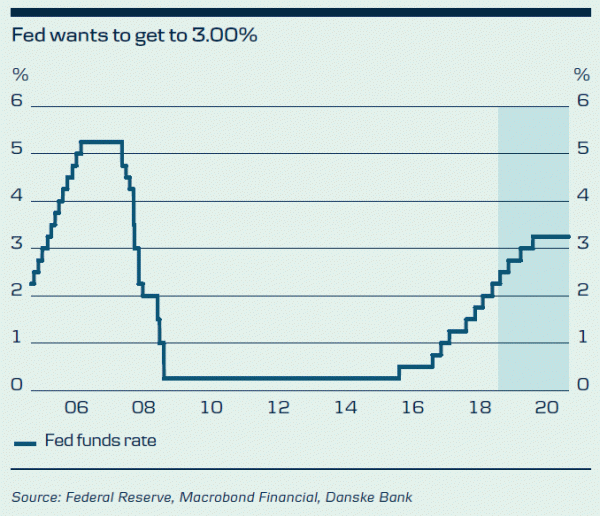
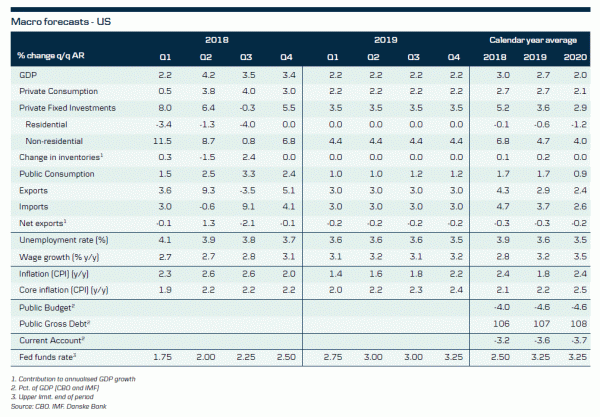 Trump has become a lame duck
Trump has become a lame duck
The midterm elections ended as expected with a divided Congress, where the Democrats won control over the House and the Republicans retained power in the Senate. This means President Trump has become a ‘lame duck’ on domestic policy, as he will be unable to push his policy agenda through. This is also the main reason why we thought and still believe that the midterms have had limited implications for the economy and markets, as they will not lead to any major changes to economic policy. While Trump cannot make new tax cuts, the Democrats are unable to roll back tax reforms from December 2017. Trump and some Democrats have talked about making infrastructure investments but we think it is easier said than done.
With Trump as a ‘lame duck’, his focus is now turning to foreign and trade policy. We already know that Trump is more hawkish on foreign policy than President Obama, but the question is what Trump will do on trade policy. It is possible to argue that he will become more aggressive or more pragmatic. Based on the recent development, it seems like Trump wants to strike a deal with China, which would be positive for market risk sentiment and the economy.
Based on the election result, our base case is that Trump will lose the presidential election in 2020 but it is difficult to forecast an election result so far away. What is more interesting is that even if the Democrats are able to win the presidency, it is difficult to see the political gridlock going away, as the Democrats will have a difficult path winning Senate control also next time.




